
Did you know the world is home to a whopping 400,000 types of flowering plants? That’s quite an impressive number! In this colorful and huge family of plants, we find a collection of beautiful flowers that all share one thing: they start with the letter U.
Although it might be a bit overlooked, this group contains some of the most unique and captivating blooms you might ever encounter. We guarantee that learning about these beautiful flowers that start with U will add a sprinkle of joy and wonder to your day!
1. Upright Prairie Coneflower
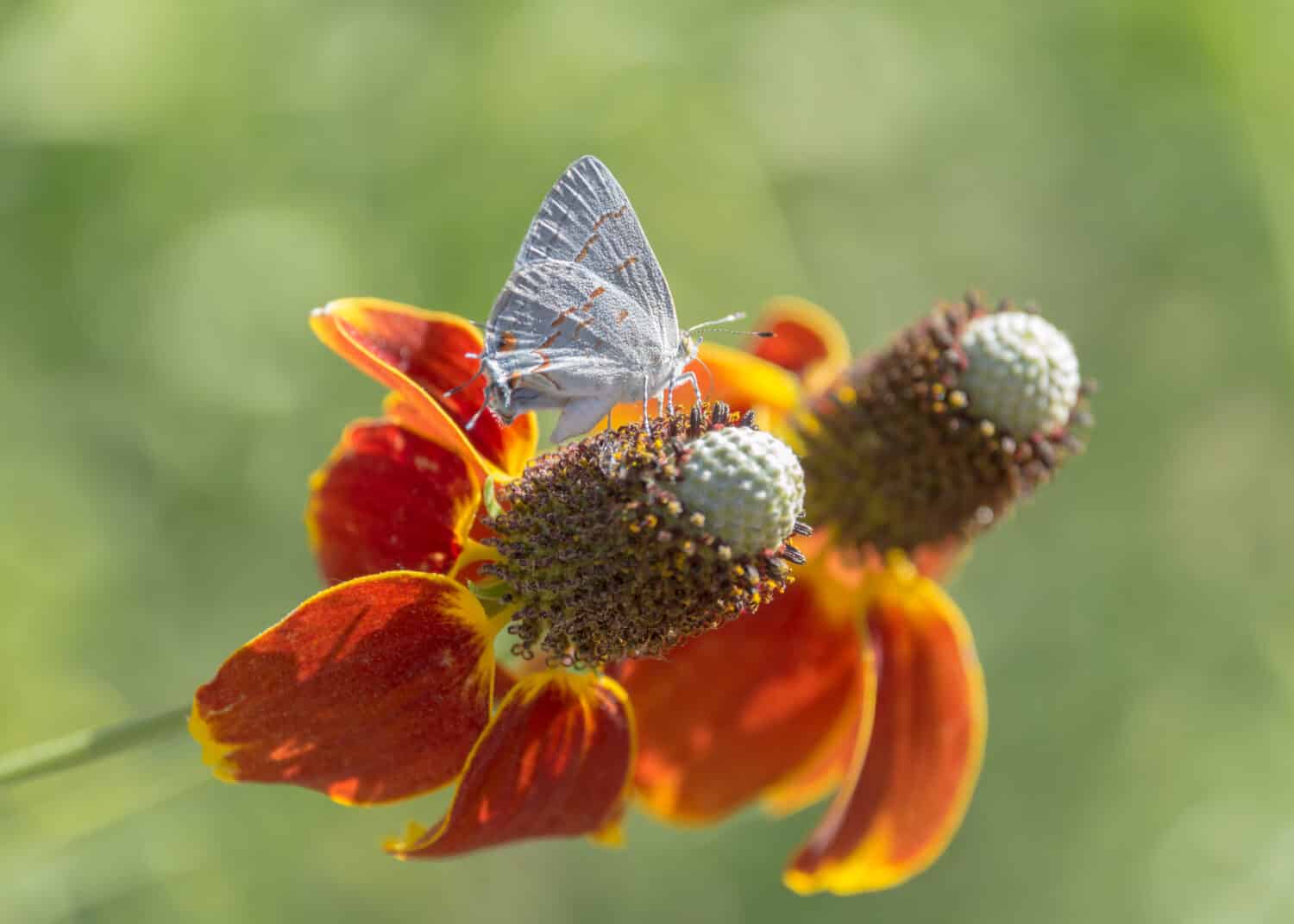
The upright coneflower is a gorgeous flower with an extended center part.
©Lori Bonati/Shutterstock.com
The first flower that starts with U is the upright prairie coneflower. It is a perennial plant that thrives well into the later seasons, belonging to the Aster family. Typically, it possesses a sturdy taproot and extends vertically from its woody base, reaching a height between 12 and 24 inches. Its ample, pinnate leaves are separated into either linear or lanceolate sections, arranged alternatively along the branching stems.
The flowers range in color from yellow and dark red to purple, brown, and maroon. Resembling a small sombrero, the flower heads comprise both ray and disk florets, prominently sitting atop tall stems devoid of leaves.
This plant graces us with its display from June through November, brightening the landscapes across the Great Plains. It is a natural and drought-resistant wildflower native to a wide region, stretching from south-central Canada to the northern parts of Mexico and expanding westwards from Manitoba and Minnesota all the way to southeastern Idaho.
2. Umbrella Sedge
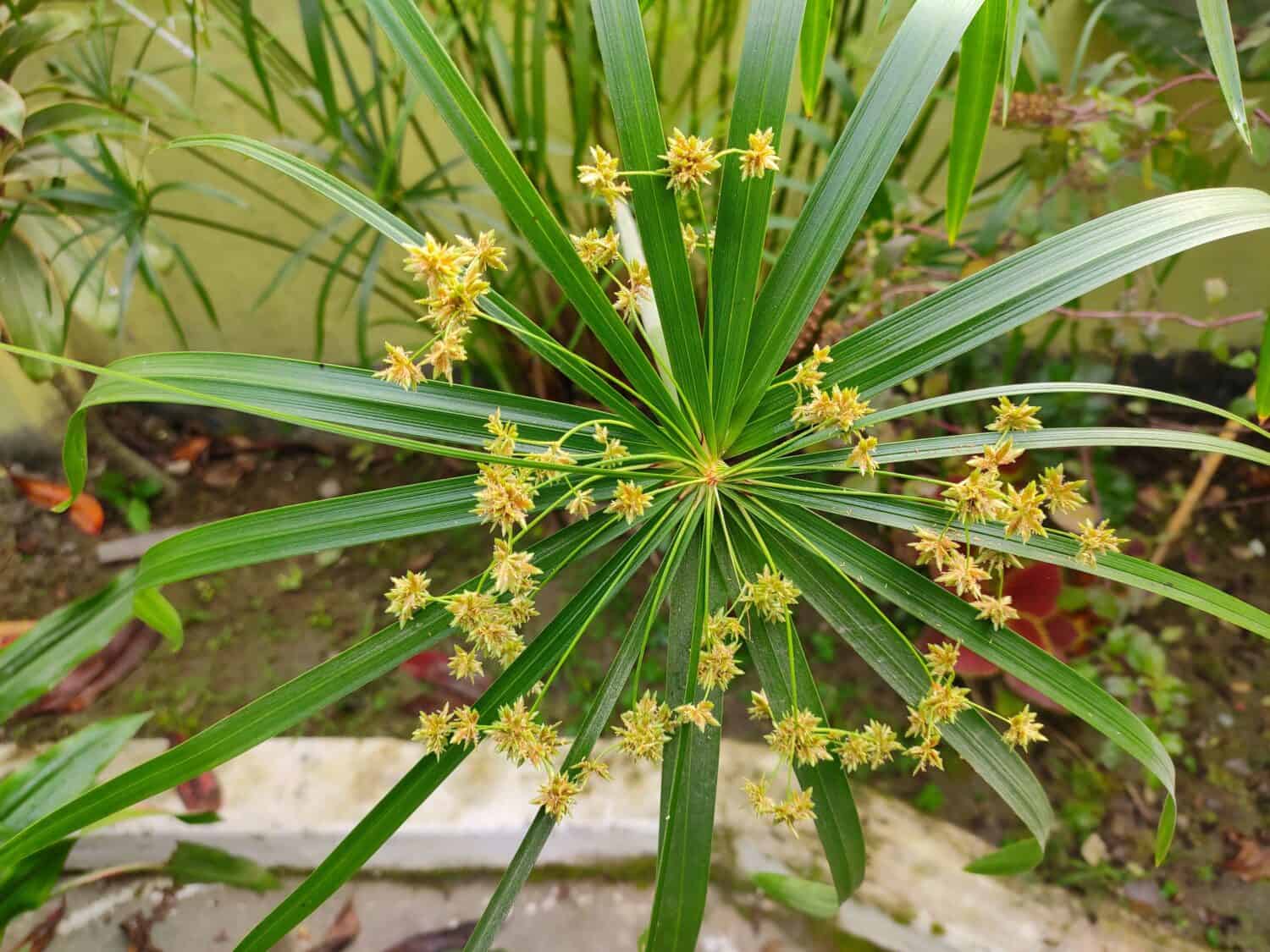
Native to
Africa
and the Middle East, umbrella sedge is a unique flowering plant for any garden.
©GYAN PRATIM RAICHOUDHURY/Shutterstock.com
The umbrella sedge gets its name from the distinctive bracts that sprout from its long stems, resembling the spokes of an umbrella. These bracts are often mistaken for leaves. It’s a bit challenging to differentiate the actual leaves of this plant from the stem, as they grip the stem tightly.
The flowers are green and white and can be found in various formations, including as a head, spike, or umbel. These flowers, which are less than an inch in size, come to life during the summer and fall seasons.
Originally hailing from regions such as West Africa, Madagascar, and the Arabian Peninsula, this plant has managed to spread extensively across different parts of the globe.
3. Upright Yellow Flax
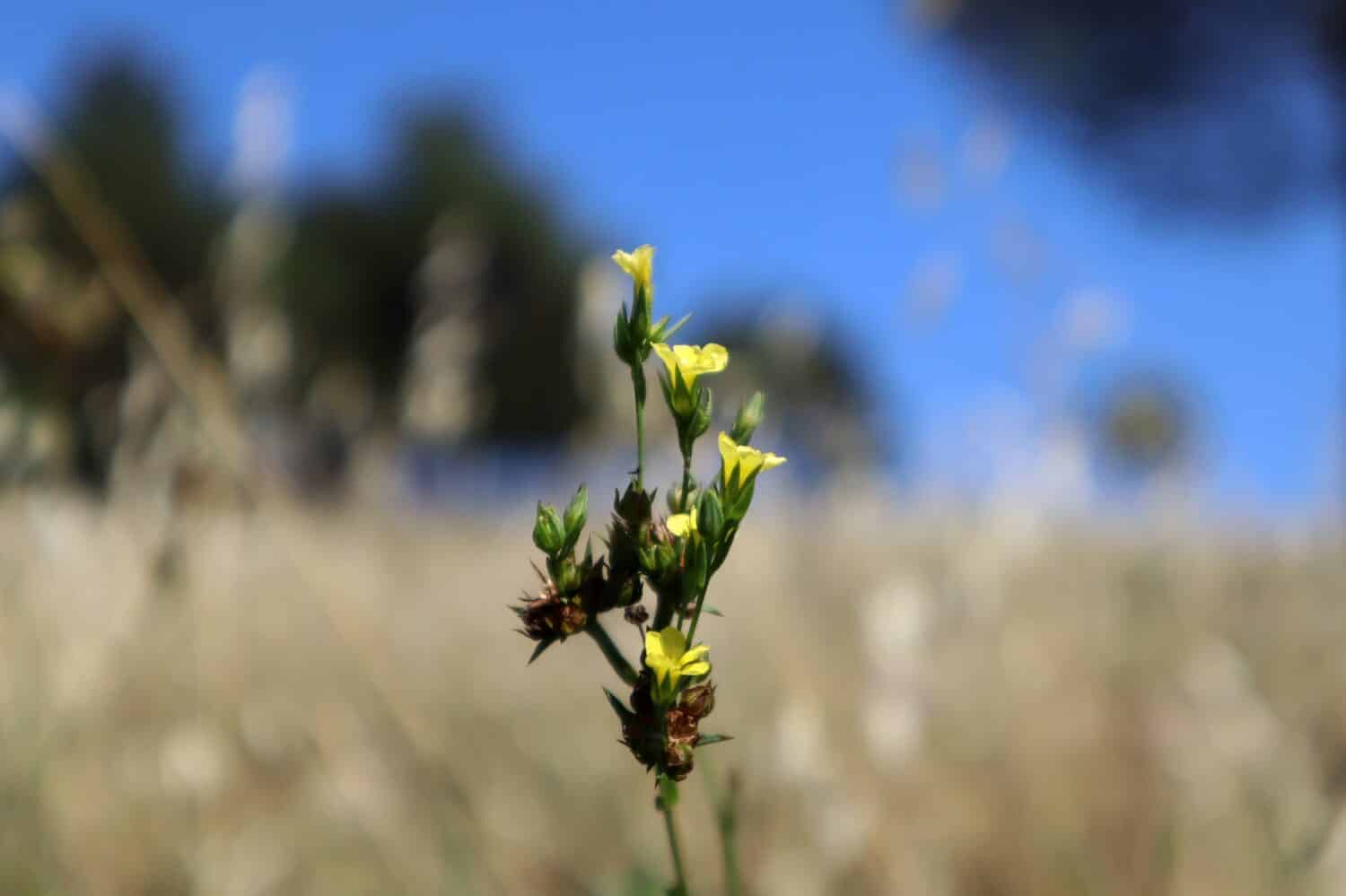
Thriving in Mediterranean climates, the upright yellow flax is a unique flower that starts with U.
©lasha36/Shutterstock.com
Upright yellow flax is an annual, which means it completes its lifecycle quickly during periods of favorable conditions, then endures the harsh winter or dry spells as seeds.
This flora graces the surroundings with its delicate yellow flowers from February to May. Each flower is adorned with five sepals and an equal number of petals, accompanied by five stamens, and features a gynoecium with five fused styles extending along its length.
Native to the Mediterranean area, this plant adds to the rich biodiversity of the region.
4. Unicorn Plant
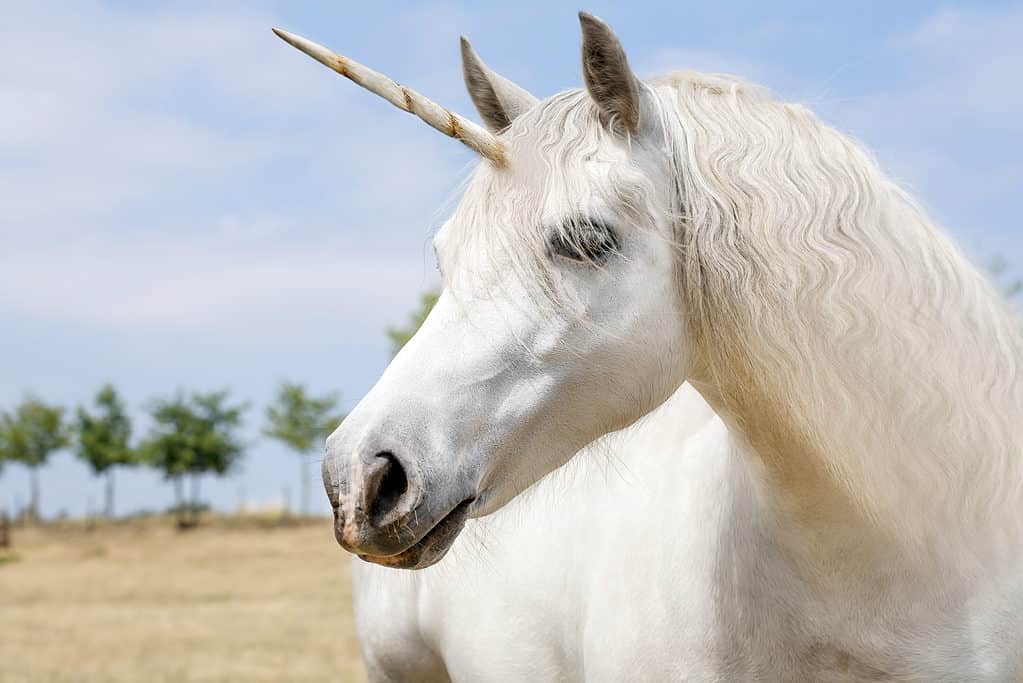
The unicorn plant is cultivated primarily for its unique fruit.
©Marben/Shutterstock.com
Next up on our list of flowers that start with U is the gorgeous unicorn plant. The unicorn plant is cultivated primarily for its unique fruit, characterized by hanging, horn-shaped, hard pods with a robust structure. These pods are approximately 3 to 4 inches long and extend into a curved beak that can be as long, if not longer, than the body. As they dry, the beaks open to reveal two claw-shaped structures.
The flowers of the unicorn plant have a tubular structure that flares open to reveal five lobes, showcasing a color spectrum from white through lavender to pink. The upper pair of lobes arches backward, as do the lateral ones, while the lower lobe extends downward, creating a captivating appearance.
This plant is native to the arid regions in the southwestern part of the United States. Thriving in sandy environments, it graces the area with its flowers during the scorching summer months. This perennial herb sprouts from a substantial, tuber-like yellow root.
5. Upright Myrtle Spurge

Growing across much of southern Europe and Asia, the upright myrtle spurge is a unique-looking flower that starts with U.
©Jeremy Christensen/Shutterstock.com
The upright myrtle spurge is a perennial plant that initially grows vertically before spreading out. The stems of this plant are adorned with succulent, bluish-green leaves forming tight spirals.
In spring, it showcases small groupings of star-like yellow-green blooms, surrounded by a halo of vibrant yellow to chartreuse bracts, occasionally blended with hints of pink. When temperatures drop, the leaves might adopt a bronze or red hue. Be cautious when handling the plant. The stems secrete a milky substance that can irritate your skin; we highly recommend wearing gloves.
The upright myrtle spurge originated in Southern Europe and parts of Asia and is frequently called donkey tail or creeping spurge.
6. Utah Agave
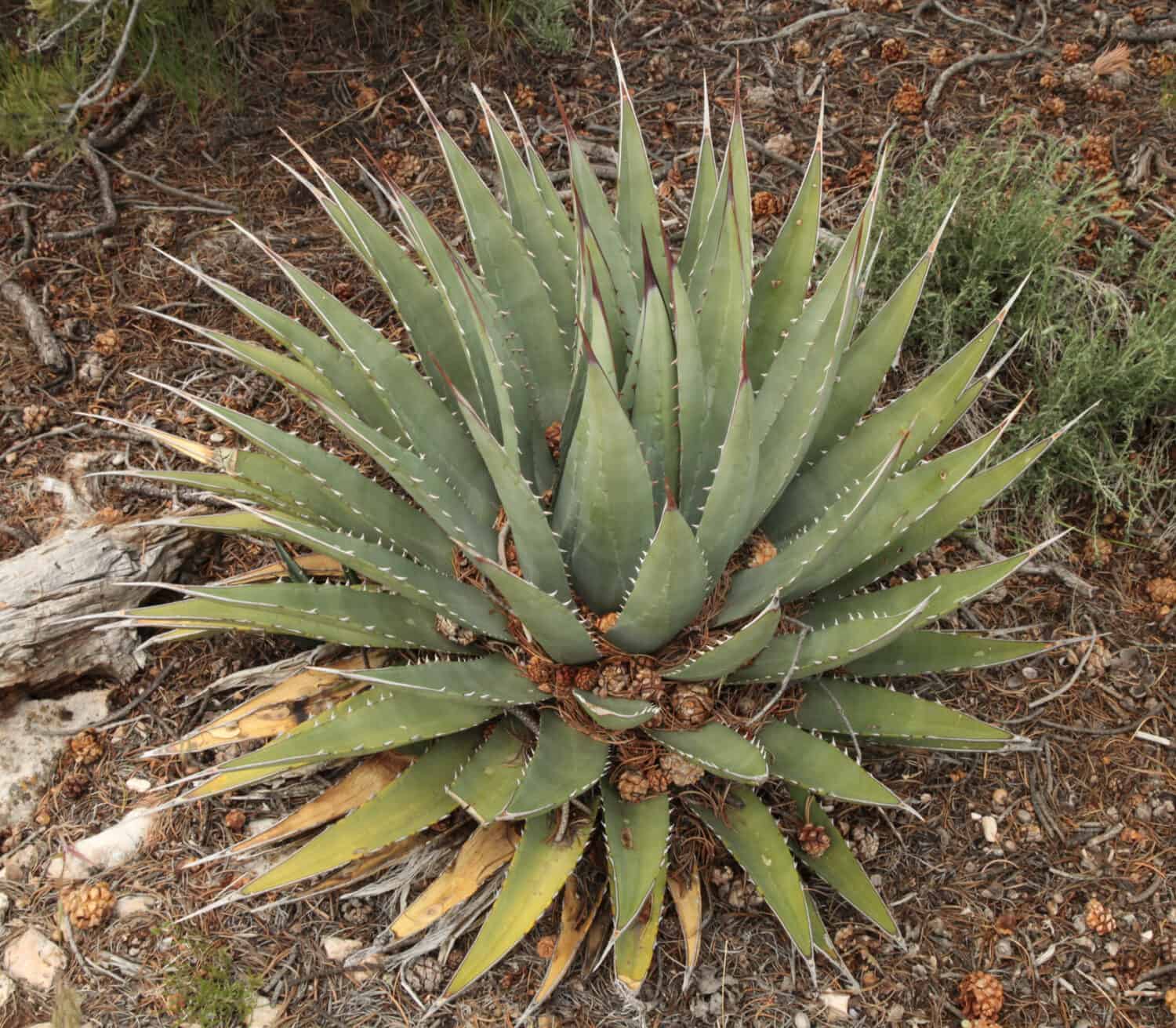
The Utah agave is another beautiful flowering plant that starts with the letter U.
©Nikki Yancey/Shutterstock.com
Recognized as one of the most cold-hardy agave species, the Utah agave is a small, perennial green succulent that develops into clusters of dense, slim, arching leaves that are edged with spines and showcase a bluish-gray color. Each leaf culminates in a lengthy, dark spine at the end. Utah agaves can survive in the cooler USDA hardiness zone 6, while most agaves thrive in hardiness zones 8 to 10.
As they reach maturity, these plants flourish during the latter part of winter, unveiling gatherings of radiant yellow flowers along a stem that stands 6 to 12 feet tall. Following the flowering phase, they bear fruit. These capsules measure between 0.4 and 1 inch in length, encapsulating black seeds.
This plant is native to regions such as California, Nevada, Arizona, and Utah. It finds its home amidst canyons and rocky terrains situated in shrublands or pinyon-juniper ecosystems.
7. Uruguayan Firecracker Plant

©Matt Lavin, CC BY-SA 2.0 , via Wikimedia Commons – Original / License
The Uruguayan firecracker plant is a magnet for hummingbirds, making it a splendid addition to any garden aimed at attracting these swift birds.
This perennial plant is a hardy choice, capable of withstanding both high temperatures and dry conditions. During the warm season, it bursts into a spectacle of vibrant orange, upward-facing, tubular blooms. The plant also features soft, silver-gray foliage that adds to its appeal, covering a structure that grows up to 2 feet high and stretches 3 feet wide during its growth period.
It flaunts a blooming period extending from the late spring until the fall. Also, it reaches heights of up to 2 feet before arching over to form expansive 3-foot mounds. The plant boasts stems and leaves with a soft, bluish-grey hue that lends a velvety touch to the garden.
Originally found in the South American regions of Uruguay and Brazil, this flower, starting with U, brings a red flair to your garden.
8. Upland White Goldenrod

A native wildflower in Missouri, the upland white goldenrod is another flower that starts with U.
©nnattalli/Shutterstock.com
The upland white goldenrod, a native of the prairies, is indeed a member of the goldenrod family, even though its blossoms are white rather than the typical yellow. This plant features many tiny, white, daisy-like blooms that draw in a diverse group of insects, including butterflies, flies, bees, and beetles, many of which are pollinators. It thrives best in sandy soils that are on the drier side, showcasing remarkable drought resistance.
Each flower, measuring about half an inch in diameter, comprises 10 to 20 white rays. They encircle a center disk that showcases shades ranging from creamy white to soft yellow.
This flower is a native wildflower in Missouri that pops up in late spring.
9. Upright Clematis
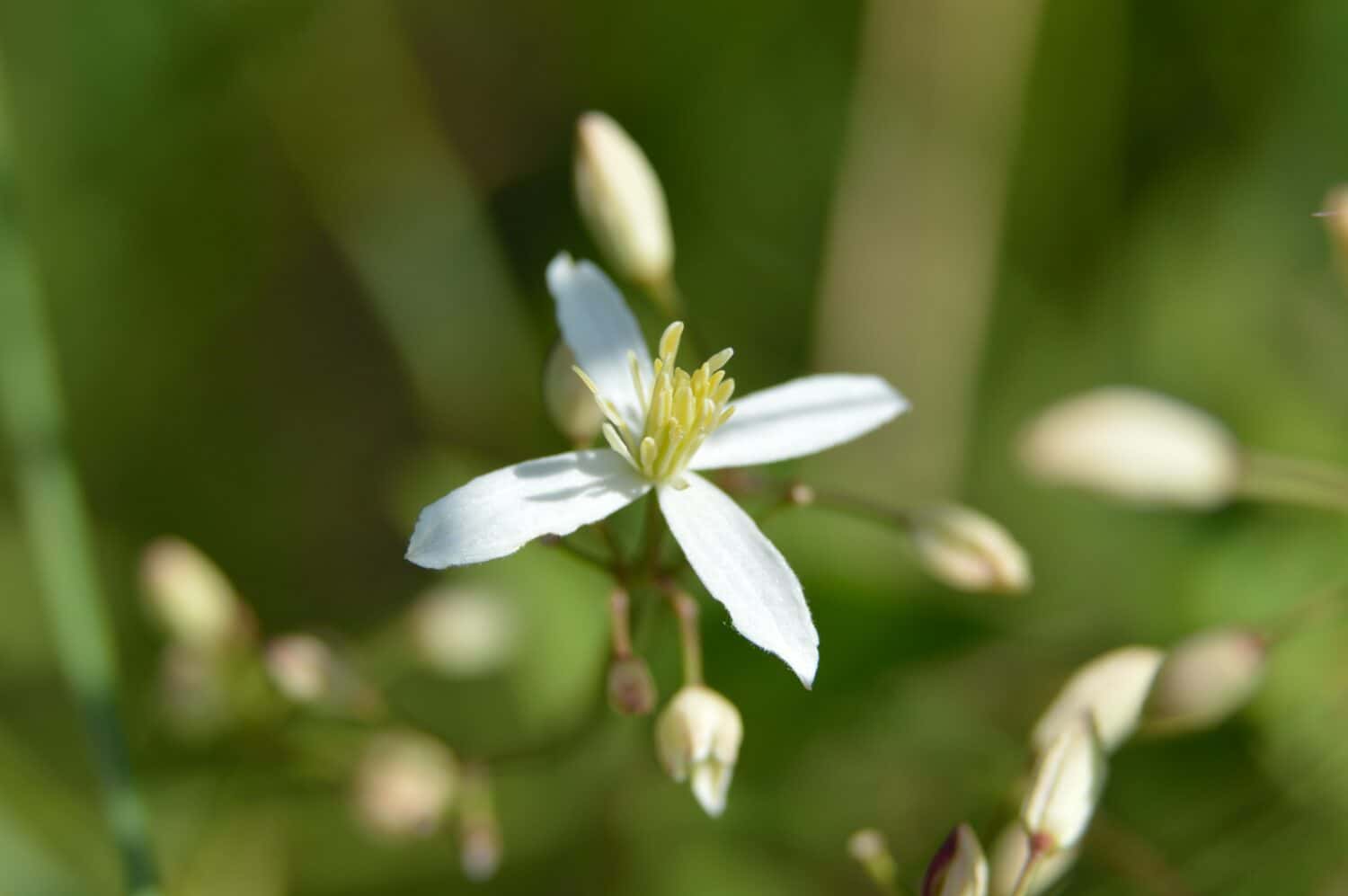
A perennial herb with gorgeous starry white flowers, the upright clematis is originally from Eurasia.
©SATRIA NANGISAN/Shutterstock.com
The upright clematis instantly catches the eye as a perennial herb with a unique structure. This flower has clusters of aromatic, starry white blossoms that grace its vertical stems throughout the summer.
Its deep green leaves are arranged in a pinnate compound pattern, and they act as a charming complement to the flowers. Adaptable to a range of environments, it thrives in soil that allows good water drainage and can flourish under the full glare of the sun or in slightly shaded areas.
Originally hailing from Eurasia, it has established itself in North America, particularly in several northern territories. In the New England region, it has made its home specifically in New Hampshire, where it can be spotted in open fields, alongside forests, and near residential areas.
10. Umbrella Magnolia

The flowers of the umbrella magnolia reach up to 10 inches in diameter.
©ArtoPhotoDesigno Studio/Shutterstock.com
The umbrella magnolia is a deciduous tree, often reaching heights between 15 and 30 feet, with a maximum trunk width of about 4 inches. Characterized by its upright structure and somewhat irregular branching, this tree adds a unique texture to any landscape or garden. Its leaves, which are arranged alternately on the branches, have an unusual elongated shape, stretching from 10 to 24 inches in length and spanning 6 to 10 inches in width. These leaves are what give the tree the name “umbrella”.
Despite their large size and appealing creamy white color, the flowers, which measure between 6 and 10 inches in diameter, carry a musky fragrance that might not be to everyone’s liking. Blooming from May to early June, these blossoms, composed of 6 to 12 tepals, attract various insects that aid in pollination.
The umbrella magnolia is one of eight types of magnolia trees indigenous to the United States. This species is especially common in the Appalachian mountain region.
11. Utah Serviceberry

A gorgeous shrub boasting white flowers, the Utah serviceberry is a plant that starts with U.
©Danita Delimont/Shutterstock.com
The Utah serviceberry often manifests as a small tree or shrub, either developing multiple branches or appearing in groups. It usually reaches a height of around 15 feet when fully grown.
Its flowers, showcasing delicate white petals, assemble in large clusters. During spring, these clusters transform the entire plant into a spectacle of pristine white beauty, a phase that lasts from April to June. Following the blooming period, it bears fruit: small apple-resembling pomes that darken to a brown or black hue upon ripening.
You can find this perennial deciduous tree growing naturally in the arid northwestern and southwestern parts of the United States, extending slightly into the northern territory of Mexico. Specifically, the Utah serviceberry flourishes at high altitudes between 5,000 and 9,000 feet.
12. Umbrella Palm

An ornamental plant, the umbrella plant boasts yellow-green flowers.
©GYAN PRATIM RAICHOUDHURY/Shutterstock.com
The umbrella plant sports slender, flat leaves that measure between 6 and 10 inches in length. These leaves symmetrically adorn the plant’s triangular stems, congregating mainly at the top. At the heart of the leaf clusters, tiny yellow-green blossoms emerge, largely going unnoticed yet forming a charming canopy resembling an umbrella.
These subtle green flowers create a captivating sight with their umbrella-shaped formation centered amidst the foliage. Thriving in environments from partial shade to areas with ample sunlight, the umbrella palms adapt well to various lighting conditions.
Originally found in Madagascar and Mauritius, the plant has successfully spread across a range of tropical and subtropical regions.
13. Urn Plant

Another flower that starts with U, the urn plant has incredibly striking blooms.
©KSCHiLI/Shutterstock.com
The urn plant is an extremely unique flower that starts with U. This plant is known for its visually striking, star-shaped blossoms, accented with coral-pink layers, mostly seen from the middle of winter to early winter. Its broad, blade-like leaves retain a green color, enhanced with prominent silver patterns all year round, contributing to its role as a favored evergreen houseplant. The urn plant has a well-defined structure with foliage that elegantly curves.
Its name is inspired by the plant’s core, which resembles a vase or an urn, a characteristic that helps it collect water in its native settings. If you choose to plant this flower in your home garden, refill this natural reservoir regularly, to mimic the plant’s original environment.
This species is native to the southeastern parts of Brazil.
14. Ursinia

With 65 varieties, ursinia is a genus of flowers in the daisy family.
©SERG KOVALENKO/Shutterstock.com
Ursinia represents a genus of plants native to Africa in the daisy family. These plants can be identified as either yearly blooming herbs or long-lasting shrubs. A distinctive feature of these plants is their leaves, which usually appear in alternate patterns and showcase serrated edges.
You can identify these plants by their spherical clusters of flowers of medium to large size, although there are a few smaller variants. A significant characteristic of these species is the elongated stems supporting the flowers. Surrounding the flowers, one can observe several layers of leaf-like structures, gradually decreasing in length as they extend outward.
At present, the Ursinia species predominantly inhabit the African continent, boasting 65 varieties mainly distributed along the coastlines of South Africa.
15. Uinta Basin Hookless Cactus

A threatened species, the Uinta Basin hookless cactus boasts aromatic flowers.
The Uinta Basin hookless cactus is facing threats from various environmental changes and human activities. Recognized as a threatened species on the federal list in the United States, its survival is of growing concern.
This cactus distinguishes itself with a round or elongated structure, exhibiting colors ranging from green to a slightly bluish tint, all enveloped in a glossy texture. Its areoles, or the small areas on the cactus where the spines emerge, are adorned with a multitude of spines varying in color from white and tan to black.
In a captivating display, it blooms to reveal aromatic, funnel-shaped flowers that span about 2 inches in both length and width, boasting pink tepals with a touch of brown on the outer sections.
This particular species is uniquely found in the United States, specifically confined to the Uinta Basin area in Utah.
Comprehensive List of All Flowers that Start with U
- Upright Prairie Coneflower
- Umbrella Sedge
- Upright Yellow Flax
- Unicorn Plant (Devil’s Claw)
- Upright Myrtle Spurge
- Utah Agave
- Uruguayan Firecracker Plant
- Upland White Goldenrod
- Upright Clematis
- Umbrella Magnolia
- Utah Serviceberry
- Umbrella Palm
- Urn Plant
- Ursinia
- Uinta Basin Hookless Cactus
Summary of Flowers That Start With U
| Number | Flower | Scientific Name |
|---|---|---|
| 1 | Upright Prairie Coneflower | Ratibida columnifera |
| 2 | Umbrella Sedge | Cyperus alternifolius |
| 3 | Upright Yellow Flax | Linum strictum |
| 4 | Unicorn Plant | Proboscidea louisianica |
| 5 | Upright Myrtle Spurge | Euphorbia rigida |
| 6 | Utah Agave | Agave utahensis |
| 7 | Uruguayan Firecracker Plant | Dicliptera squarrosa |
| 8 | Upland White Goldenrod | Solidago ptarmicoides |
| 9 | Upright Clematis | Clematis recta |
| 10 | Umbrella Magnolia | Magnolia tripetala |
| 11 | Utah Serviceberry | Amelanchier utahensis |
| 12 | Umbrella Palm | Cyperus alternifolius |
| 13 | Urn Plant | Aechmea fasciata |
| 14 | Ursinia | Ursinia |
| 15 | Uinta Basin Hookless Cactus | Sclerocactus glaucus |
The photo featured at the top of this post is © SERG KOVALENKO/Shutterstock.com
Thank you for reading! Have some feedback for us? Contact the AZ Animals editorial team.







